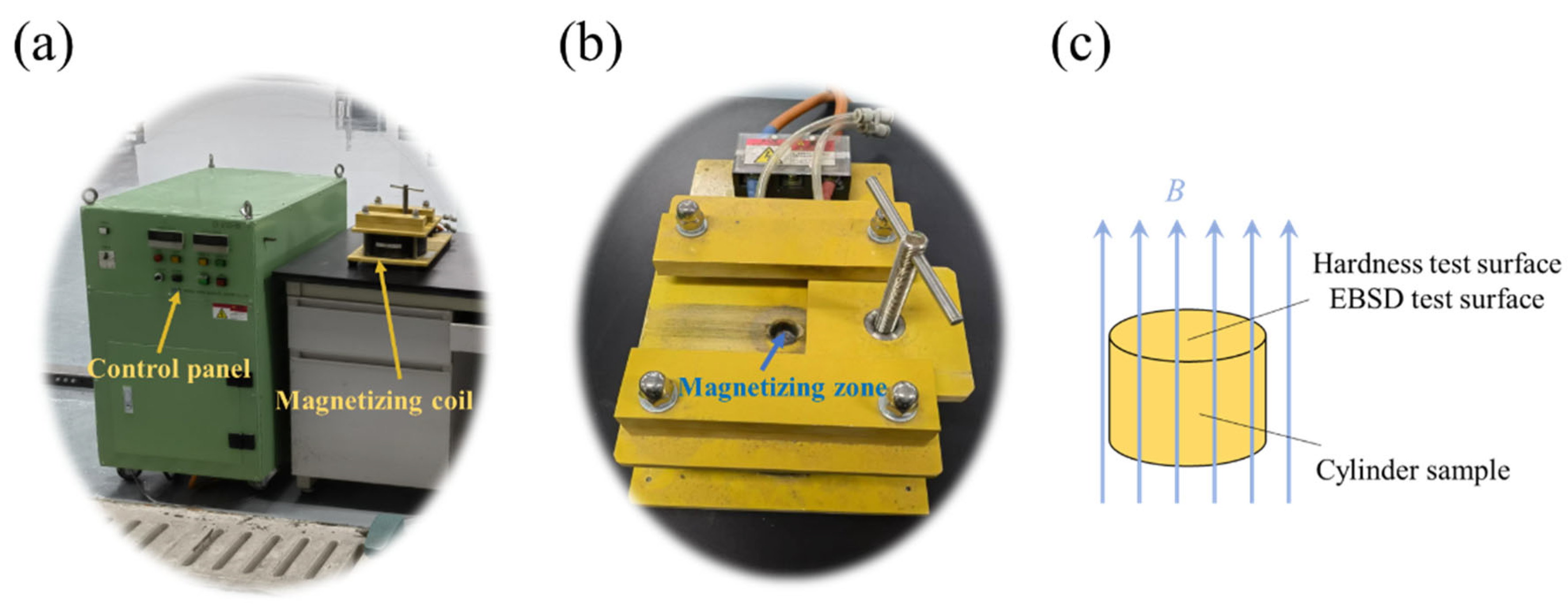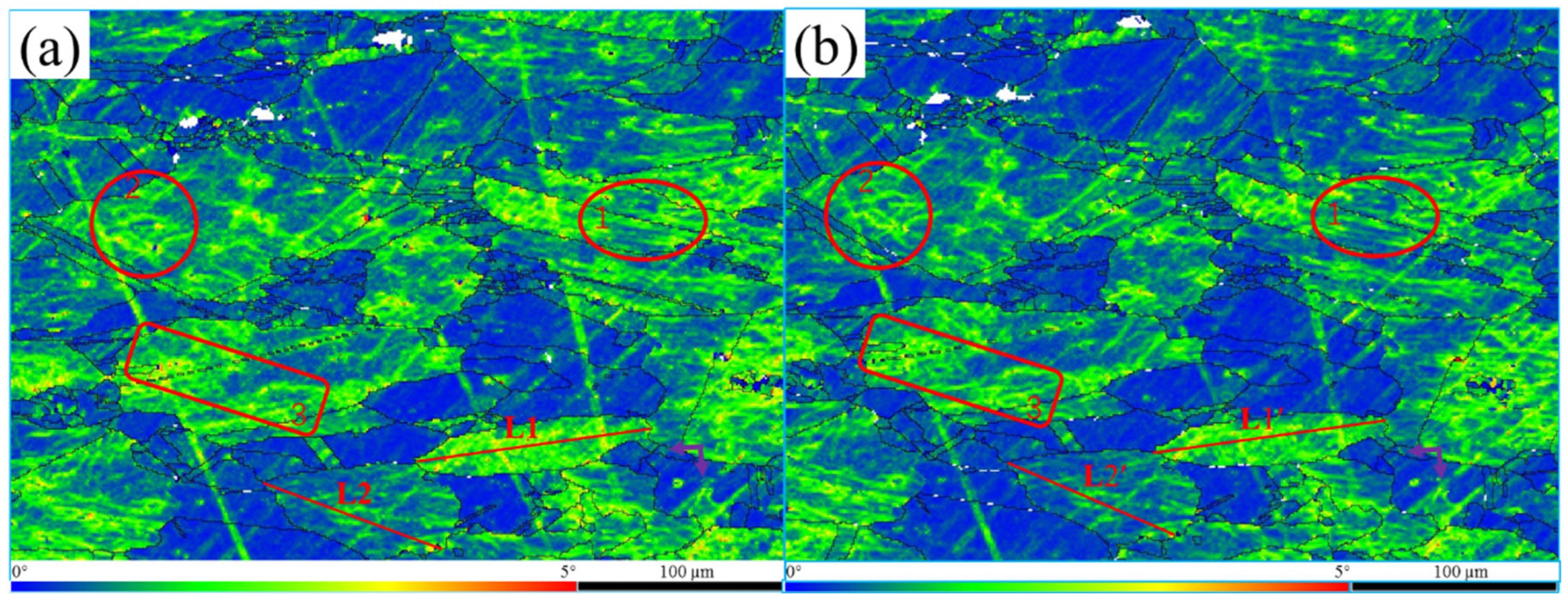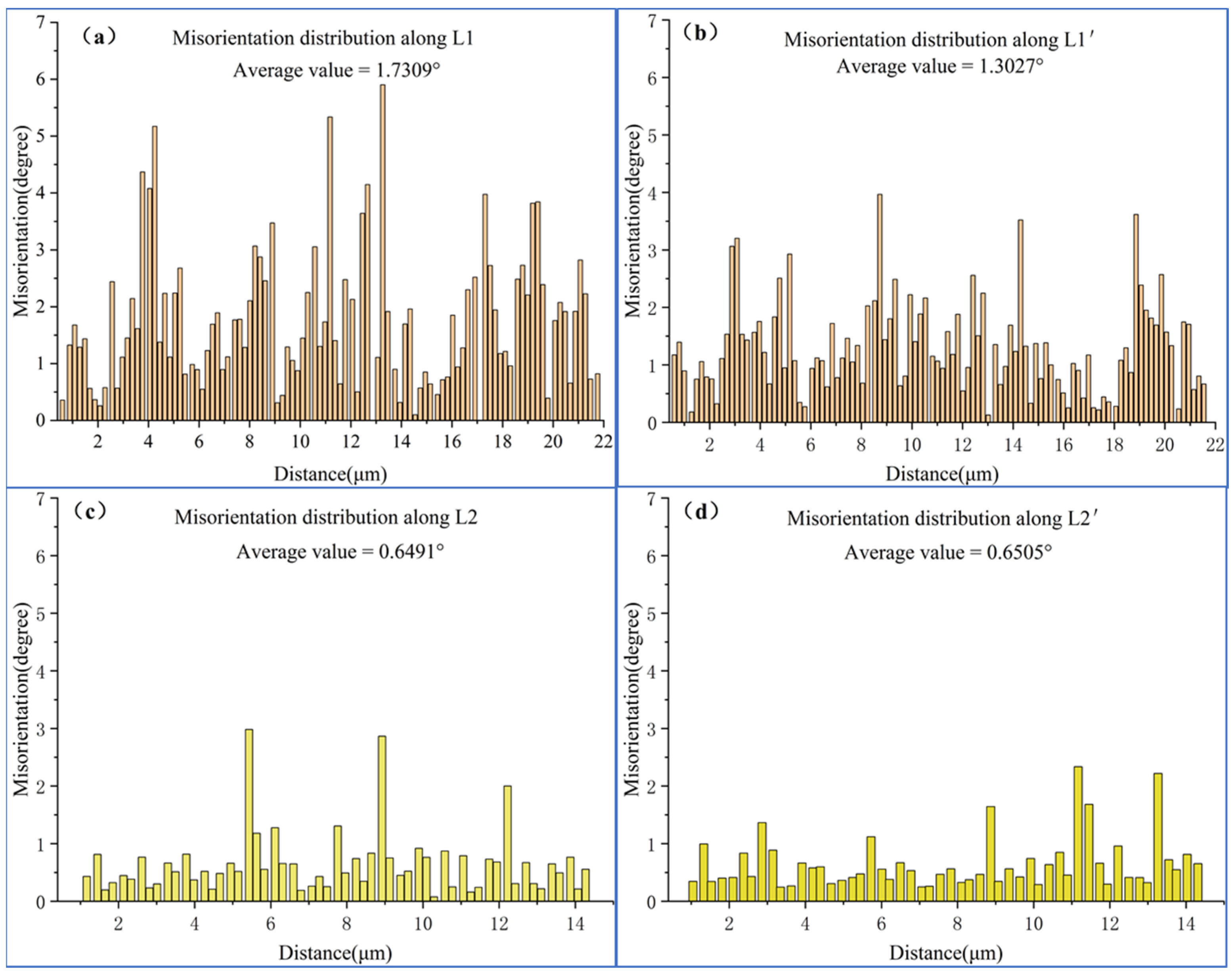Effect of Pulsed Magnetic Field on the Microstructure of QAl9-4 Aluminium Bronze and Its Mechanism
Abstract
1. Introduction
2. Materials and Methods
3. Results
3.1. Effect of Magnetic Field Treatment on Dislocation
3.2. Effect of Magnetic Field Treatment on Grain Boundary
3.3. Effect of Magnetic Field Treatment on Microhardness
4. Discussion
5. Conclusions
- (1)
- The pulsed magnetic field treatment could change the distribution of dislocations and eliminate dislocations in the aluminium bronze alloy, decreasing dislocation density, especially in deformed grains.
- (2)
- The pulsed magnetic field can improve the efficiency of dislocation depinning of aluminium bronze alloy. The dislocation moves under the action of the magnetic field and original stress field, which causes the rotation of LAGBs. The misorientation of adjacent points inside the grain gradually decreases.
- (3)
- The magnetic field decreases the alloy’s residual stress and the quantity of dislocation pile-up. Meanwhile, the magnetic field induces the elimination of deformation twins and mitigates the strengthening effect of twins. Macroscopically, it demonstrates a decrease in the alloy’s microhardness.
Author Contributions
Funding
Institutional Review Board Statement
Informed Consent Statement
Data Availability Statement
Conflicts of Interest
References
- Hasan, F.; Jahanafrooz, A.; Lorimer, G.W.; Ridley, N. The morphology, crystallography, and chemistry of phases in as-cast nickel-aluminium bronze. Metall. Mater. Trans. A 1982, 13, 1337–1345. [Google Scholar] [CrossRef]
- Xu, X.; Zhao, H.; Hu, Y.; Zong, L.; Qin, J.; Zhang, J.; Shao, J. Effect of hot compression on the microstructure evolution of aluminium bronze alloy. J. Mater. Res. Technol. 2022, 19, 3760–3776. [Google Scholar] [CrossRef]
- Fu, Y.; Huang, Y.; Liu, Z.; Guo, R.; Li, S. Mechanical behaviors of novel multiple principal elements CuAl10Fe5Ni5Mn1.2 wt% with micro-nano structures. J. Alloy. Compd. 2020, 843, 155993. [Google Scholar] [CrossRef]
- Zeng, Y.; Yang, F.; Chen, Z.; Guo, E.; Gao, M.; Wang, X.; Kang, H.; Wang, T. Enhancing mechanical properties and corrosion resistance of nickel-aluminium bronze via hot rolling process. J. Mater. Sci. Technol. 2021, 61, 186–196. [Google Scholar] [CrossRef]
- Chen, W.; Chen, Y.; Wen, T.; Min, W.; Zhang, T.; Feng, X. Effect of ultrasonic vibration on microstructure and tensile properties of aluminium bronze alloy produced by wire arc additive manufacturing. Chin. J. Nonferrous Met. 2020, 30, 2280–2294. [Google Scholar]
- Orzolek, S.M.; Semple, J.K.; Fisher, C.R. Influence of Processing on the Microstructure of Nickel Aluminium Bronze (NAB). Addit. Manuf. 2022, 56, 102859. [Google Scholar]
- Hu, Y.; Zhao, H.; Yu, X.; Li, J.; Zhang, B.; Li, T. Research Progress of Magnetic Field Regulated Mechanical Property of Solid Metal Materials. Metals 2022, 12, 1988. [Google Scholar] [CrossRef]
- Li, G.R.; Cheng, J.F.; Wang, H.M.; Li, C.Q. Influence of Static Magnetic Field on Microstructure and Properties of 7055 Aluminium Alloy. Rare Met. Mater. Eng. 2019, 48, 1036–1045. [Google Scholar]
- Akram, S.; Babutskyi, A.; Chrysanthou, A.; Montalvão, D.; Whiting, M.J.; Pizurova, N. Improvement of the wear resistance of nickel-aluminium bronze and 2014-T6 aluminium alloy by application of alternating magnetic field treatment. Wear 2021, 480, 203940. [Google Scholar] [CrossRef]
- Akram, S.; Babutskyi, A.; Chrysanthou, A.; Montalvão, D.; Pizurova, N. Effect of alternating magnetic field on the fatigue behaviour of EN8 steel and 2014-T6 aluminium alloy. Metals 2019, 9, 984. [Google Scholar] [CrossRef]
- Liao, C.; Qin, Y.; Yang, Y.; Xu, G.; Yang, G.; Gao, H.; Wu, M. Enhanced service life of nickel-based alloy die for copper extrusion by pulsed magnetic field. J. Manuf. Process. 2022, 81, 798–806. [Google Scholar] [CrossRef]
- Ye, J.; Guan, R.; Zhao, H.; Yin, A. Effect of Zr content on the precipitation and dynamic softening behavior in Al-Fe-Zr alloys. Mater. Charact. 2020, 162, 110181. [Google Scholar] [CrossRef]
- Zribi, Z.; Ktari, H.H.; Herbst, F.; Optasanu, V.; Njah, N. EBSD, XRD and SRS characterization of a casting Al-7wt% Si alloy processed by equal channel angular extrusion: Dislocation density evaluation. Mater. Charact. 2019, 153, 190–198. [Google Scholar] [CrossRef]
- Gao, H.; Huang, Y.; Nix, W.D.; Hutchinson, J.W. Mechanism based strain gradient plasticity I. Theory. J. Mech. Phys. Solids 1999, 47, 1239–1263. [Google Scholar] [CrossRef]
- Kubin, L.P.; Mortensen, A. Geometrically necessary dislocations and strain-gradient plasticity: A few critical issues. Scr. Mater. 2003, 48, 119–125. [Google Scholar] [CrossRef]
- Li, G.R.; Li, Y.M.; Wang, F.F.; Wang, H.M. Microstructure and performance of solid TC4 titanium alloy subjected to the high pulsed magnetic field treatment. J. Alloy. Compd. 2015, 644, 750–756. [Google Scholar] [CrossRef]
- Zhao, F.; Wang, L.; Fan, D.; Bie, B.X.; Zhou, X.M.; Suo, T.; Li, Y.L.; Chen, M.W.; Liu, C.L.; Qi, M.L.; et al. Macrodeformation twins in single-crystal aluminium. Phys. Rev. Lett. 2016, 116, 075501. [Google Scholar] [CrossRef]
- Hou, M.; Li, K.; Li, X.; Zhang, X.; Rui, S.; Wu, Y.; Cai, Z. Effects of pulsed magnetic fields of different intensities on dislocation density, residual stress, and hardness of Cr4Mo4V steel. Crystals 2020, 10, 115. [Google Scholar] [CrossRef]
- Rao, K.S.S.; Allamraju, K.V. Effect on micro-hardness and residual stress in CNC turning of aluminium 7075 alloy. Mater. Today Proc. 2017, 4, 975–981. [Google Scholar]
- Xu, S.; Xiong, L.; Chen, Y.; McDowell, D.L. An analysis of key characteristics of the Frank-Read source process in FCC metals. J. Mech. Phys. Solids 2016, 96, 460–476. [Google Scholar] [CrossRef]
- Prevey, P.S. X-ray Diffraction Residual Stress Techniques; ASM International, ASM Handbook: Almere, The Netherlands, 1986; Volume 10, pp. 380–392. [Google Scholar]
- Molotskii, M.I. Theoretical basis for electro-and magnetoplasticity. Mater. Sci. Eng. A 2000, 287, 248–258. [Google Scholar] [CrossRef]
- Kontsevoi, O.Y.; Mryasov, O.N.; Gornostyrev, Y.N.; Freeman, A.J.; Katsnelson, M.I.; Trefilov, A.V. Real-space first-principles electronic structure of edge dislocations: NiAl. Philos. Mag. Lett. 1998, 78, 427–433. [Google Scholar] [CrossRef]
- Zhang, X.; Zhao, Q.; Cai, Z.; Pan, J. Effects of magnetic field on the residual stress and structural defects of Ti-6Al-4V. Metals 2020, 10, 141. [Google Scholar] [CrossRef]
- Golovin, Y.I. Mechanochemical reactions between structural defects in magnetic fields. J. Mater. Sci. 2004, 39, 5129–5134. [Google Scholar] [CrossRef]
- Li, G.R.; Wang, F.F.; Wang, H.M.; Cheng, J.F. Microstructure and Mechanical Properties of TC4 Titanium Alloy Subjected to High Static Magnetic Field. Mater. Sci. Forum 2017, 898, 345–354. [Google Scholar] [CrossRef]
- Yan, M.; Wang, C.; Luo, T.; Li, Y.; Feng, X.; Huang, Q.; Yang, Y. Effect of Pulsed Magnetic Field on the Residual Stress of Rolled Magnium Alloy AZ31 Sheet. Acta Metall. Sin. 2021, 34, 45–53. [Google Scholar] [CrossRef]
- Xu, Q.; Li, K.; Cai, Z.; Wu, Y. Effect of pulsed magnetic field on the microstructure of TC4 titanium alloy and its mechanism. Acta Metall. Sin. 2019, 55, 489–495. [Google Scholar]
- Li, L.; Zhang, Z.; Zhang, P.; Zhang, Z. A review on the fatigue cracking of twin boundaries: Crystallographic orientation and stacking fault energy. Prog. Mater. Sci. 2022, 131, 101011. [Google Scholar] [CrossRef]
- Chen, Y.; Kang, X.H.; Xiao, N.M.; Zheng, C.W.; Li, D.Z. Phase field modelling of grain growth in polycrystalline material. Acta Phys. Sin. 2009, 58, 124–131. [Google Scholar] [CrossRef]
- Li, Q.; Song, J.; Liu, G.S.; Liu, Y.; Wang, J.; Zeng, X.Q. Migration kinetics of twinning disconnections in nanotwinned Cu: An in situ HRTEM deformation study. Scr. Mater. 2021, 194, 113621. [Google Scholar] [CrossRef]
- Peng, S.; Wei, Y.; Jin, Z.; Yang, W. Supersonic screw dislocations gliding at the shear wave speed. Phys. Rev. Lett. 2019, 122, 045501. [Google Scholar] [CrossRef] [PubMed]







Publisher’s Note: MDPI stays neutral with regard to jurisdictional claims in published maps and institutional affiliations. |
© 2022 by the authors. Licensee MDPI, Basel, Switzerland. This article is an open access article distributed under the terms and conditions of the Creative Commons Attribution (CC BY) license (https://creativecommons.org/licenses/by/4.0/).
Share and Cite
Hu, Y.; Zhao, H.; Li, J.; Hu, K.; Qin, J. Effect of Pulsed Magnetic Field on the Microstructure of QAl9-4 Aluminium Bronze and Its Mechanism. Materials 2022, 15, 8336. https://doi.org/10.3390/ma15238336
Hu Y, Zhao H, Li J, Hu K, Qin J. Effect of Pulsed Magnetic Field on the Microstructure of QAl9-4 Aluminium Bronze and Its Mechanism. Materials. 2022; 15(23):8336. https://doi.org/10.3390/ma15238336
Chicago/Turabian StyleHu, Yujun, Hongjin Zhao, Junwei Li, Kefu Hu, and Jing Qin. 2022. "Effect of Pulsed Magnetic Field on the Microstructure of QAl9-4 Aluminium Bronze and Its Mechanism" Materials 15, no. 23: 8336. https://doi.org/10.3390/ma15238336
APA StyleHu, Y., Zhao, H., Li, J., Hu, K., & Qin, J. (2022). Effect of Pulsed Magnetic Field on the Microstructure of QAl9-4 Aluminium Bronze and Its Mechanism. Materials, 15(23), 8336. https://doi.org/10.3390/ma15238336





